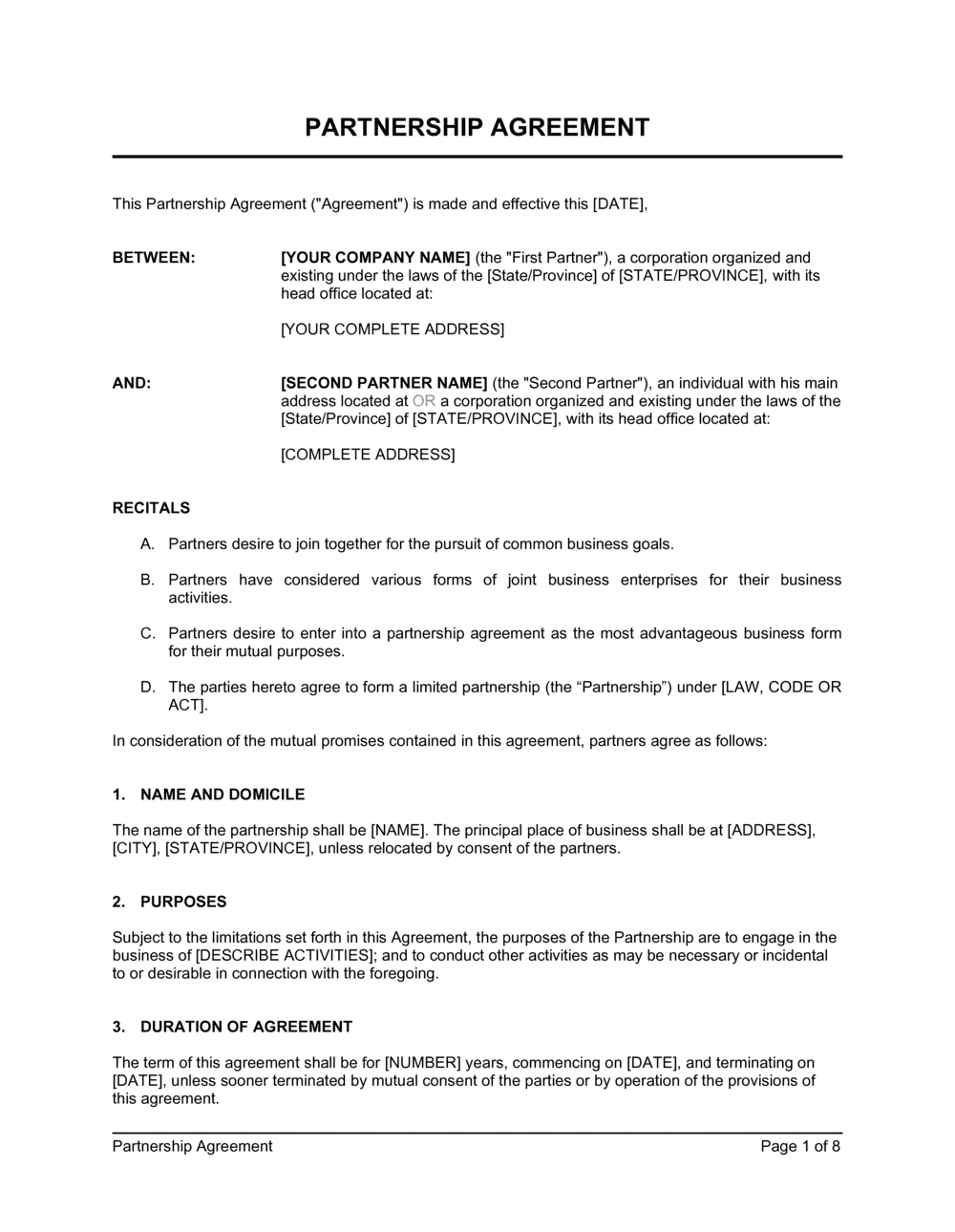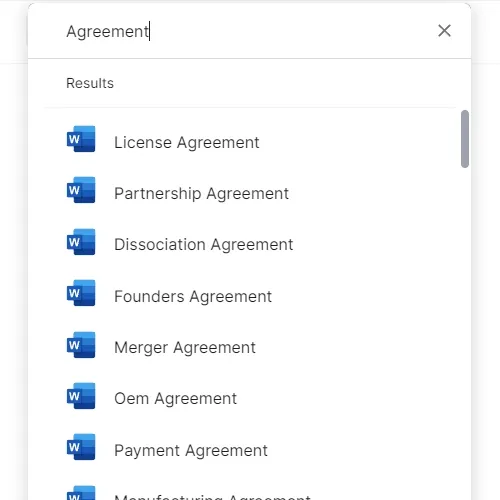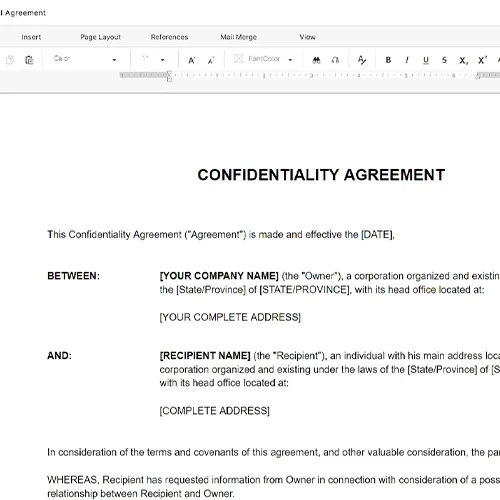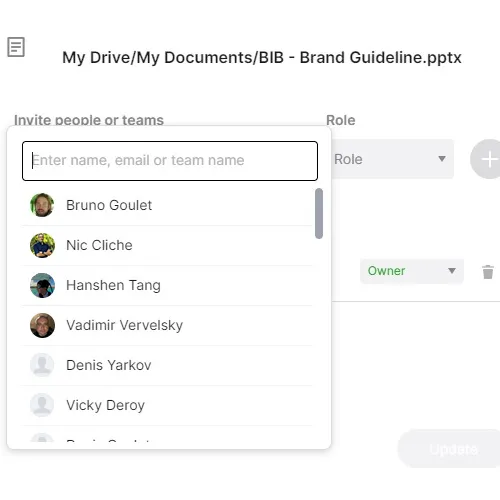Partnership Agreement Template

Crafting a Partnership Agreement to Establish Clear Terms and Foster Successful Business Relationships
Forming a business partnership is an exciting endeavor, bringing together resources, expertise, and a shared vision to build something greater than what an individual could accomplish alone. However, to ensure the partnership is productive, fair, and built for longevity, it’s crucial to formalize it with a legally binding Partnership Agreement. This agreement serves as a foundational document, defining the structure, roles, responsibilities, and expectations of all partners involved. By clearly laying out these terms, a partnership agreement helps prevent misunderstandings, secures each partner’s interests, and supports long-term business success.
In this comprehensive guide, we’ll explore the essential components of a partnership agreement, discuss why these agreements are vital, and introduce additional supporting documents that can add further protection and flexibility to your partnership.
Understanding the Partnership Agreement Template
A partnership agreement template provides a structured format for defining the terms of a business partnership. The template typically includes essential sections that outline the rights, responsibilities, and protections for each partner. These sections ensure that all critical aspects of the partnership are addressed and that each partner understands their role in the venture.
Standard sections in a partnership agreement template include:
- Partnership Structure and Contributions
- Roles and Responsibilities
- Profit and Loss Distribution
- Decision-Making and Management
- Partner Withdrawals and New Partners
- Dispute Resolution
- Dissolution of Partnership
- Confidentiality and Non-Compete Clauses
Using a comprehensive template from Business in a Box allows you to create a professional, legally sound document. Each section can be customized to reflect your partnership’s specific needs, ensuring a solid foundation for your business relationship.
Why a Partnership Agreement is Essential for Success
A partnership agreement is more than a legal formality; it’s a strategic tool that defines the expectations, commitments, and obligations of each partner. Here’s how a partnership agreement can support your business and set you up for long-term success:
- Establishes Clear Roles and Expectations
One of the primary benefits of a partnership agreement is its ability to define each partner’s role and responsibilities. By clarifying duties, the agreement prevents confusion and establishes a workflow that ensures all partners understand their contributions to the business. - Protects Each Partner’s Investment
Each partner’s contribution—whether financial, intellectual, or labor-based—is formally recognized and protected in the agreement. This minimizes the risk of disputes related to contributions, safeguards investments, and creates a foundation of trust. - Defines Profit and Loss Distribution
The agreement specifies how profits and losses will be shared among partners, creating a fair system that compensates each partner according to their contributions and role within the business. - Provides a Framework for Dispute Resolution
Conflicts can arise even in the most harmonious partnerships. A well-structured partnership agreement includes a clear dispute resolution mechanism, allowing partners to address disagreements in a structured, amicable manner that reduces the risk of costly legal battles. - Offers Flexibility with Amendment Options
Partnerships evolve, and a static agreement may not serve long-term needs. Adding an Amendment Agreement to your partnership documentation allows partners to modify terms as the business grows and adapts, ensuring that the partnership remains relevant and supportive of changing business needs.
Business in a Box offers customizable partnership agreement templates that walk you through each section, ensuring you create a thorough, legally sound document that protects and strengthens your business partnership.
Key Sections of a Partnership Agreement Template
A comprehensive template is vital for creating a professional document that outlines the partnership structure and expectations. Here’s a breakdown of each key section, along with strategies to make each effective.
1. Partnership Structure and Contributions
The structure and contributions section establishes the foundation of the partnership. It defines the type of partnership, the contributions each partner makes, and how the business will operate. This section is critical for setting expectations regarding each partner’s involvement and investment.
Key elements to include:
- Type of Partnership: Define whether the arrangement is a general partnership, limited partnership, or limited liability partnership (LLP), as each type has specific legal and financial implications.
- Partner Contributions:Specify each partner’s contributions, which can include financial investments, intellectual property, or physical resources.
- Ownership Interests: Outline each partner’s percentage of ownership based on their contributions, ensuring all parties have a clear understanding of their stake in the business.
This section provides transparency regarding ownership and accountability, forming the basis of each partner’s rights and responsibilities.
2. Roles and Responsibilities
Clearly defining each partner’s roles and responsibilities is essential for a functional and efficient partnership. This section clarifies each partner’s duties, day-to-day responsibilities, and areas of decision-making authority, aligning all partners on their roles and commitments.
To make this section effective, consider including:
- Operational Roles: Outline each partner’s specific role within the business, such as CEO, CFO, or Head of Operations.
- Decision-Making Authority: Define which decisions require input from specific partners or a collective vote.
- Job Descriptions: Detail each partner’s specific tasks and responsibilities associated with their role to avoid overlaps and miscommunication.
The Business in a Box template guides you in structuring this section effectively, ensuring each partner’s duties and expectations are well-defined.
3. Profit and Loss Distribution
The profit and loss distribution section specifies how profits, losses, and expenses will be divided among partners. This ensures that each partner’s share is fair and aligns with their contributions and role within the partnership.
When structuring this section, include:
- Distribution Method: State if profits and losses will be split equally, proportionally based on ownership interest, or through another agreed-upon method.
- Payment Frequency: Define how often distributions will occur, such as monthly, quarterly, or annually.
- Reinvestment Agreement: Outline any agreements on reinvesting a portion of profits back into the business for growth or other purposes.
A clear profit and loss distribution plan fosters trust and prevents misunderstandings, ensuring each partner feels fairly compensated.
4. Decision-Making and Management
Decision-making can be challenging in partnerships, especially when opinions differ. This section establishes a framework for decision-making, specifying who has the authority to make various types of decisions and whether any require unanimous or majority votes.
Key elements to include:
- Voting Requirements: Define which decisions require unanimous consent, a majority vote, or individual authority.
- Management Structure: Outline the hierarchy and specify any committees or roles involved in decision-making.
- Approval Processes: Detail the steps for approving significant business actions, such as entering contracts, hiring personnel, or making financial investments.
A well-defined decision-making structure minimizes conflicts and ensures partners understand how decisions will be made, providing a smoother operational flow.
5. Partner Withdrawals and New Partners
Over time, partnerships may evolve, with some partners exiting or new ones joining. This section covers the processes for handling partner withdrawals, admitting new partners, and adjusting ownership interests, ensuring the business’s continuity and stability.
Consider including:
- Withdrawal Process: Outline the steps a partner must take to leave the partnership, including any required notice or buyout options.
- New Partner Admission: Define criteria and approval processes for bringing new partners into the business.
- Buyout and Valuation: Specify how a departing partner’s ownership interest will be valued and purchased by remaining partners or the partnership itself.
A clear policy on partner changes provides stability, helping the partnership adapt without disruptions.
6. Dispute Resolution
Conflicts can arise in any partnership, making a dispute resolution section essential. This part outlines the methods for handling disagreements, such as mediation, arbitration, or legal proceedings, reducing the risk of prolonged, costly conflicts.
Include:
- Dispute Resolution Method: Specify the preferred method for resolving conflicts, like mediation or arbitration.
- Arbitration Details: If arbitration is chosen, define the process, including selecting an arbitrator and applicable rules.
- Governing Law: Indicate which state or jurisdiction’s laws will govern the agreement and any disputes.
Addressing dispute resolution proactively establishes a fair approach to handling conflicts, giving partners a clear path to resolving issues amicably.
7. Dissolution of Partnership
The dissolution section details the process for ending the partnership, including winding down operations, distributing assets, and settling remaining obligations. It ensures that partners can exit the business smoothly and fairly if they decide to end the partnership.
Key elements include:
- Triggering Events: List events that may lead to dissolution, such as mutual agreement, bankruptcy, or the departure of a key partner.
- Asset Distribution: Specify how assets will be divided among partners after debts are settled.
- Dissolution Procedures: Provide a guide for winding up operations and fulfilling legal obligations.
A detailed dissolution plan prevents confusion and ensures all partners have a fair exit path.
8. Confidentiality and Non-Compete Clauses
Confidentiality and non-compete clauses are vital for safeguarding sensitive information and preventing conflicts of interest. These clauses help secure proprietary information and prevent partners from engaging in competing businesses.
To protect the partnership’s interests, include:
- Confidentiality Agreement: Require partners to maintain confidentiality regarding business operations, client lists, and trade secrets.
- Non-Compete Clause: Define restrictions on partners engaging in competing businesses during and after the partnership.
- Penalties for Breach: Specify consequences if a partner violates these clauses.
These provisions protect the business’s competitive edge and secure the partnership’s integrity.
Supporting Documents for a Comprehensive Partnership Agreement
A partnership agreement can be strengthened with additional supporting documents that add flexibility, protect confidential information, and establish processes for handling changes. Business in a Box offers templates for several essential documents that can complement your partnership agreement, enhancing security and adaptability:
- Amendment Agreement - Allows partners to make modifications to the partnership agreement as the business evolves. This document provides flexibility, ensuring that the partnership terms remain aligned with the business’s growth and changing needs. Explore our Amendment Agreement templates.
- Buy-Sell Agreement - Outlines the procedures for buying or selling partnership interests. This document is essential for managing ownership changes due to events like retirement or departure of a partner, ensuring continuity and stability in the partnership. Explore our Buy-Sell Agreement templates.
- Non-Disclosure Agreement (NDA) - Protects confidential information shared among partners, ensuring that proprietary business details are safeguarded. NDAs are particularly useful during negotiations and when handling sensitive business data. Explore our NDA templates.
- Partnership Dissolution Agreement - Outlines the terms and process for ending the partnership, providing clarity and fairness in case the business relationship needs to conclude. A dissolution agreement ensures that all parties understand their rights and responsibilities upon termination. Explore our Partnership Dissolution Agreement templates.
These documents add robust layers of protection and flexibility to your partnership, ensuring that each partner’s interests are secure and that the partnership can adapt to new situations.
How Business in a Box Simplifies Partnership Agreement Creation
Creating a detailed, legally sound partnership agreement from scratch can be a time-consuming process. Business in a Box’s partnership agreement templates provide a streamlined, pre-structured framework that simplifies the process, allowing you to quickly create a thorough, professional agreement.
With Business in a Box, you gain access to:
- Time Savings - With pre-structured templates, you can efficiently draft partnership agreements that cover all essential elements.
- Customizable Design - Each template is adaptable, allowing you to tailor it to the unique terms and requirements of your partnership.
- Enhanced Professionalism - A clear, organized agreement fosters trust and ensures all parties understand their commitments and responsibilities.
- Legal and Compliance Assurance - Crafted by experts, Business in a Box templates follow best practices, helping your partnership agreement meet professional and legal standards and minimizing potential risks.
In addition to partnership agreements, Business in a Box offers over 3,000 templates covering various business needs, including contracts, operational documents, financial plans, and more. This extensive suite of resources allows you to manage and grow your business with ease.
Getting Started with Business in a Box
Creating a partnership agreement with Business in a Box’s templates provides a solid, legally compliant foundation for your business relationship. By following the structured sections and prompts, you ensure that all essential details are covered, fostering transparency, trust, and effective collaboration among partners.
To get started:
- Define Partnership Goals and Terms - Clarify each partner’s contributions, roles, and expectations before using the template.
- Customize the Template - Tailor each section of the Business in a Box partnership agreement template to reflect your specific business needs.
- Include Supporting Documents - Attach relevant supporting documents, such as an Amendment Agreement, Buy-Sell Agreement, NDA, and Partnership Dissolution Agreement, to create a robust framework.
- Review and Finalize - Have each partner review the agreement and supporting documents, ensuring that all terms are clearly understood.
- Seek Legal Review - Consider a legal review to confirm the agreement’s compliance with local laws and to ensure all parties’ interests are fully protected.
With a comprehensive partnership agreement and supporting documents in place, your business is well-positioned for long-term success, allowing each partner to focus on growth, collaboration, and achieving shared goals.
Final Thoughts
A well-structured partnership agreement is essential for building a successful, collaborative business relationship. By clearly defining each partner’s roles, contributions, and legal rights, this document serves as both a guide and a safeguard, promoting accountability, trust, and mutual understanding.
Business in a Box offers an extensive suite of templates, including essential supporting documents such as the Amendment Agreement, Buy-Sell Agreement, NDA, and Partnership Dissolution Agreement, making it easy to create a legally sound partnership agreement and manage every aspect of your business. With structured guidance and customizable templates, you can focus on developing a partnership that drives growth, flexibility, and long-term success.
Ready to start? Explore our Partnership Agreement templates and discover how Business in a Box can simplify your document creation, empowering you to establish a solid foundation for your business partnership and protect its future.
Reviewed on

Crafting a Partnership Agreement to Establish Clear Terms and Foster Successful Business Relationships
Forming a business partnership is an exciting endeavor, bringing together resources, expertise, and a shared vision to build something greater than what an individual could accomplish alone. However, to ensure the partnership is productive, fair, and built for longevity, it’s crucial to formalize it with a legally binding Partnership Agreement. This agreement serves as a foundational document, defining the structure, roles, responsibilities, and expectations of all partners involved. By clearly laying out these terms, a partnership agreement helps prevent misunderstandings, secures each partner’s interests, and supports long-term business success.
In this comprehensive guide, we’ll explore the essential components of a partnership agreement, discuss why these agreements are vital, and introduce additional supporting documents that can add further protection and flexibility to your partnership.
Understanding the Partnership Agreement Template
A partnership agreement template provides a structured format for defining the terms of a business partnership. The template typically includes essential sections that outline the rights, responsibilities, and protections for each partner. These sections ensure that all critical aspects of the partnership are addressed and that each partner understands their role in the venture.
Standard sections in a partnership agreement template include:
- Partnership Structure and Contributions
- Roles and Responsibilities
- Profit and Loss Distribution
- Decision-Making and Management
- Partner Withdrawals and New Partners
- Dispute Resolution
- Dissolution of Partnership
- Confidentiality and Non-Compete Clauses
Using a comprehensive template from Business in a Box allows you to create a professional, legally sound document. Each section can be customized to reflect your partnership’s specific needs, ensuring a solid foundation for your business relationship.
Why a Partnership Agreement is Essential for Success
A partnership agreement is more than a legal formality; it’s a strategic tool that defines the expectations, commitments, and obligations of each partner. Here’s how a partnership agreement can support your business and set you up for long-term success:
- Establishes Clear Roles and Expectations
One of the primary benefits of a partnership agreement is its ability to define each partner’s role and responsibilities. By clarifying duties, the agreement prevents confusion and establishes a workflow that ensures all partners understand their contributions to the business. - Protects Each Partner’s Investment
Each partner’s contribution—whether financial, intellectual, or labor-based—is formally recognized and protected in the agreement. This minimizes the risk of disputes related to contributions, safeguards investments, and creates a foundation of trust. - Defines Profit and Loss Distribution
The agreement specifies how profits and losses will be shared among partners, creating a fair system that compensates each partner according to their contributions and role within the business. - Provides a Framework for Dispute Resolution
Conflicts can arise even in the most harmonious partnerships. A well-structured partnership agreement includes a clear dispute resolution mechanism, allowing partners to address disagreements in a structured, amicable manner that reduces the risk of costly legal battles. - Offers Flexibility with Amendment Options
Partnerships evolve, and a static agreement may not serve long-term needs. Adding an Amendment Agreement to your partnership documentation allows partners to modify terms as the business grows and adapts, ensuring that the partnership remains relevant and supportive of changing business needs.
Business in a Box offers customizable partnership agreement templates that walk you through each section, ensuring you create a thorough, legally sound document that protects and strengthens your business partnership.
Key Sections of a Partnership Agreement Template
A comprehensive template is vital for creating a professional document that outlines the partnership structure and expectations. Here’s a breakdown of each key section, along with strategies to make each effective.
1. Partnership Structure and Contributions
The structure and contributions section establishes the foundation of the partnership. It defines the type of partnership, the contributions each partner makes, and how the business will operate. This section is critical for setting expectations regarding each partner’s involvement and investment.
Key elements to include:
- Type of Partnership: Define whether the arrangement is a general partnership, limited partnership, or limited liability partnership (LLP), as each type has specific legal and financial implications.
- Partner Contributions:Specify each partner’s contributions, which can include financial investments, intellectual property, or physical resources.
- Ownership Interests: Outline each partner’s percentage of ownership based on their contributions, ensuring all parties have a clear understanding of their stake in the business.
This section provides transparency regarding ownership and accountability, forming the basis of each partner’s rights and responsibilities.
2. Roles and Responsibilities
Clearly defining each partner’s roles and responsibilities is essential for a functional and efficient partnership. This section clarifies each partner’s duties, day-to-day responsibilities, and areas of decision-making authority, aligning all partners on their roles and commitments.
To make this section effective, consider including:
- Operational Roles: Outline each partner’s specific role within the business, such as CEO, CFO, or Head of Operations.
- Decision-Making Authority: Define which decisions require input from specific partners or a collective vote.
- Job Descriptions: Detail each partner’s specific tasks and responsibilities associated with their role to avoid overlaps and miscommunication.
The Business in a Box template guides you in structuring this section effectively, ensuring each partner’s duties and expectations are well-defined.
3. Profit and Loss Distribution
The profit and loss distribution section specifies how profits, losses, and expenses will be divided among partners. This ensures that each partner’s share is fair and aligns with their contributions and role within the partnership.
When structuring this section, include:
- Distribution Method: State if profits and losses will be split equally, proportionally based on ownership interest, or through another agreed-upon method.
- Payment Frequency: Define how often distributions will occur, such as monthly, quarterly, or annually.
- Reinvestment Agreement: Outline any agreements on reinvesting a portion of profits back into the business for growth or other purposes.
A clear profit and loss distribution plan fosters trust and prevents misunderstandings, ensuring each partner feels fairly compensated.
4. Decision-Making and Management
Decision-making can be challenging in partnerships, especially when opinions differ. This section establishes a framework for decision-making, specifying who has the authority to make various types of decisions and whether any require unanimous or majority votes.
Key elements to include:
- Voting Requirements: Define which decisions require unanimous consent, a majority vote, or individual authority.
- Management Structure: Outline the hierarchy and specify any committees or roles involved in decision-making.
- Approval Processes: Detail the steps for approving significant business actions, such as entering contracts, hiring personnel, or making financial investments.
A well-defined decision-making structure minimizes conflicts and ensures partners understand how decisions will be made, providing a smoother operational flow.
5. Partner Withdrawals and New Partners
Over time, partnerships may evolve, with some partners exiting or new ones joining. This section covers the processes for handling partner withdrawals, admitting new partners, and adjusting ownership interests, ensuring the business’s continuity and stability.
Consider including:
- Withdrawal Process: Outline the steps a partner must take to leave the partnership, including any required notice or buyout options.
- New Partner Admission: Define criteria and approval processes for bringing new partners into the business.
- Buyout and Valuation: Specify how a departing partner’s ownership interest will be valued and purchased by remaining partners or the partnership itself.
A clear policy on partner changes provides stability, helping the partnership adapt without disruptions.
6. Dispute Resolution
Conflicts can arise in any partnership, making a dispute resolution section essential. This part outlines the methods for handling disagreements, such as mediation, arbitration, or legal proceedings, reducing the risk of prolonged, costly conflicts.
Include:
- Dispute Resolution Method: Specify the preferred method for resolving conflicts, like mediation or arbitration.
- Arbitration Details: If arbitration is chosen, define the process, including selecting an arbitrator and applicable rules.
- Governing Law: Indicate which state or jurisdiction’s laws will govern the agreement and any disputes.
Addressing dispute resolution proactively establishes a fair approach to handling conflicts, giving partners a clear path to resolving issues amicably.
7. Dissolution of Partnership
The dissolution section details the process for ending the partnership, including winding down operations, distributing assets, and settling remaining obligations. It ensures that partners can exit the business smoothly and fairly if they decide to end the partnership.
Key elements include:
- Triggering Events: List events that may lead to dissolution, such as mutual agreement, bankruptcy, or the departure of a key partner.
- Asset Distribution: Specify how assets will be divided among partners after debts are settled.
- Dissolution Procedures: Provide a guide for winding up operations and fulfilling legal obligations.
A detailed dissolution plan prevents confusion and ensures all partners have a fair exit path.
8. Confidentiality and Non-Compete Clauses
Confidentiality and non-compete clauses are vital for safeguarding sensitive information and preventing conflicts of interest. These clauses help secure proprietary information and prevent partners from engaging in competing businesses.
To protect the partnership’s interests, include:
- Confidentiality Agreement: Require partners to maintain confidentiality regarding business operations, client lists, and trade secrets.
- Non-Compete Clause: Define restrictions on partners engaging in competing businesses during and after the partnership.
- Penalties for Breach: Specify consequences if a partner violates these clauses.
These provisions protect the business’s competitive edge and secure the partnership’s integrity.
Supporting Documents for a Comprehensive Partnership Agreement
A partnership agreement can be strengthened with additional supporting documents that add flexibility, protect confidential information, and establish processes for handling changes. Business in a Box offers templates for several essential documents that can complement your partnership agreement, enhancing security and adaptability:
- Amendment Agreement - Allows partners to make modifications to the partnership agreement as the business evolves. This document provides flexibility, ensuring that the partnership terms remain aligned with the business’s growth and changing needs. Explore our Amendment Agreement templates.
- Buy-Sell Agreement - Outlines the procedures for buying or selling partnership interests. This document is essential for managing ownership changes due to events like retirement or departure of a partner, ensuring continuity and stability in the partnership. Explore our Buy-Sell Agreement templates.
- Non-Disclosure Agreement (NDA) - Protects confidential information shared among partners, ensuring that proprietary business details are safeguarded. NDAs are particularly useful during negotiations and when handling sensitive business data. Explore our NDA templates.
- Partnership Dissolution Agreement - Outlines the terms and process for ending the partnership, providing clarity and fairness in case the business relationship needs to conclude. A dissolution agreement ensures that all parties understand their rights and responsibilities upon termination. Explore our Partnership Dissolution Agreement templates.
These documents add robust layers of protection and flexibility to your partnership, ensuring that each partner’s interests are secure and that the partnership can adapt to new situations.
How Business in a Box Simplifies Partnership Agreement Creation
Creating a detailed, legally sound partnership agreement from scratch can be a time-consuming process. Business in a Box’s partnership agreement templates provide a streamlined, pre-structured framework that simplifies the process, allowing you to quickly create a thorough, professional agreement.
With Business in a Box, you gain access to:
- Time Savings - With pre-structured templates, you can efficiently draft partnership agreements that cover all essential elements.
- Customizable Design - Each template is adaptable, allowing you to tailor it to the unique terms and requirements of your partnership.
- Enhanced Professionalism - A clear, organized agreement fosters trust and ensures all parties understand their commitments and responsibilities.
- Legal and Compliance Assurance - Crafted by experts, Business in a Box templates follow best practices, helping your partnership agreement meet professional and legal standards and minimizing potential risks.
In addition to partnership agreements, Business in a Box offers over 3,000 templates covering various business needs, including contracts, operational documents, financial plans, and more. This extensive suite of resources allows you to manage and grow your business with ease.
Getting Started with Business in a Box
Creating a partnership agreement with Business in a Box’s templates provides a solid, legally compliant foundation for your business relationship. By following the structured sections and prompts, you ensure that all essential details are covered, fostering transparency, trust, and effective collaboration among partners.
To get started:
- Define Partnership Goals and Terms - Clarify each partner’s contributions, roles, and expectations before using the template.
- Customize the Template - Tailor each section of the Business in a Box partnership agreement template to reflect your specific business needs.
- Include Supporting Documents - Attach relevant supporting documents, such as an Amendment Agreement, Buy-Sell Agreement, NDA, and Partnership Dissolution Agreement, to create a robust framework.
- Review and Finalize - Have each partner review the agreement and supporting documents, ensuring that all terms are clearly understood.
- Seek Legal Review - Consider a legal review to confirm the agreement’s compliance with local laws and to ensure all parties’ interests are fully protected.
With a comprehensive partnership agreement and supporting documents in place, your business is well-positioned for long-term success, allowing each partner to focus on growth, collaboration, and achieving shared goals.
Final Thoughts
A well-structured partnership agreement is essential for building a successful, collaborative business relationship. By clearly defining each partner’s roles, contributions, and legal rights, this document serves as both a guide and a safeguard, promoting accountability, trust, and mutual understanding.
Business in a Box offers an extensive suite of templates, including essential supporting documents such as the Amendment Agreement, Buy-Sell Agreement, NDA, and Partnership Dissolution Agreement, making it easy to create a legally sound partnership agreement and manage every aspect of your business. With structured guidance and customizable templates, you can focus on developing a partnership that drives growth, flexibility, and long-term success.
Ready to start? Explore our Partnership Agreement templates and discover how Business in a Box can simplify your document creation, empowering you to establish a solid foundation for your business partnership and protect its future.
Easily Create Any Business Document You Need in Minutes.

Download or open template
Access over 3,000+ business and legal templates for any business task, project or initiative.

Edit and fill in the blanks
Customize your ready-made business document template and save it in the cloud.

Save, Share, Export, or Sign
Share your files and folders with your team. Create a space of seamless collaboration.


